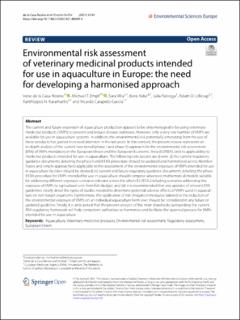| dc.contributor.author | de la Casa-Resino, Irene | |
| dc.contributor.author | Empl, Michael T. | |
| dc.contributor.author | Villa, Sara | |
| dc.contributor.author | Kolar, Boris | |
| dc.contributor.author | Fabrega, Julia | |
| dc.contributor.author | Lillicrap, Adam David | |
| dc.contributor.author | Karamanlis, Xanthippos N. | |
| dc.contributor.author | Carapeto-García, Ricardo | |
| dc.date.accessioned | 2022-03-11T08:46:21Z | |
| dc.date.available | 2022-03-11T08:46:21Z | |
| dc.date.created | 2022-02-17T12:37:25Z | |
| dc.date.issued | 2021 | |
| dc.identifier.citation | Environmental Sciences Europe. 2021, 33, 84. | en_US |
| dc.identifier.issn | 2190-4715 | |
| dc.identifier.uri | https://hdl.handle.net/11250/2984503 | |
| dc.description.abstract | The current and future expansion of aquaculture production appears to be only manageable by using veterinary medicinal products (VMPs) to prevent and reduce disease outbreaks. However, only a very low number of VMPs are available for use in aquaculture systems. In addition, the environmental risk potentially emanating from the use of these products has gained increased attention in the last years. In this context, the present review represents an in-depth analysis of the current two-tiered (phase I and phase II) approach for the environmental risk assessment (ERA) of VMPs mandatory in the European Union and the European Economic Area (EU/EEA), and its applicability to medicinal products intended for use in aquaculture. The following conclusions are drawn: (i) the current regulatory guidance documents detailing the phase I and II ERA procedure should be updated and harmonised across Member States and simple approach(es) applicable to the assessment of the environmental exposure of VMPs intended for use in aquaculture facilities should be devised; (ii) current and future regulatory guidance documents detailing the phase II ERA procedure for VMPs intended for use in aquaculture should comprise advanced mathematical models suitable for addressing different exposure scenarios relevant across the whole EU/EEA (including scenarios addressing the exposure of VMPs to agricultural soils from fish sludge); and (iii) it is recommended that any updates of relevant ERA guidelines clearly detail the types of studies needed to determine potential adverse effects of VMPs used in aquaculture on non-target organisms. Furthermore, the application of risk mitigation measures tailored to the reduction of the environmental exposure of VMPs on an individual aquaculture farm level should be considered in any future or updated guideline. Finally, it is anticipated that the present analysis of the main drawbacks surrounding the current ERA regulatory framework will help competent authorities to harmonise and facilitate the approval process for VMPs intended for use in aquaculture. | en_US |
| dc.language.iso | eng | en_US |
| dc.publisher | Springer | en_US |
| dc.rights | Navngivelse 4.0 Internasjonal | * |
| dc.rights.uri | http://creativecommons.org/licenses/by/4.0/deed.no | * |
| dc.title | Environmental risk assessment of veterinary medicinal products intended for use in aquaculture in Europe: the need for developing a harmonised approach | en_US |
| dc.type | Peer reviewed | en_US |
| dc.type | Journal article | en_US |
| dc.description.version | publishedVersion | en_US |
| dc.rights.holder | © The Author(s) 2021. | en_US |
| dc.source.pagenumber | 17 | en_US |
| dc.source.volume | 33 | en_US |
| dc.source.journal | Environmental Sciences Europe | en_US |
| dc.identifier.doi | 10.1186/s12302-021-00509-8 | |
| dc.identifier.cristin | 2002809 | |
| dc.source.articlenumber | 84 | en_US |
| cristin.ispublished | true | |
| cristin.fulltext | original | |
| cristin.qualitycode | 1 | |

